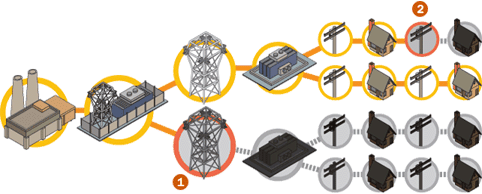Frequently Asked Questions
Not necessarily. If the cause of the outage is a generating station or transmission line or terminal, then NB Power will know immediately that there is an outage and begin steps to restore power.
If the cause is a downed distribution line, NB Power may not know about the outage until a customer calls to advise us of the situation. Please use Check Outages to determine if the outage for your location has already been reported. This information is updated every 10 minutes.
- Generating Stations: where power is produced. NB Power has generating stations located throughout the province. Transformers at the stations increase the power’s voltage for delivery into the system.
- Terminals: increase or decrease the voltage as necessary and provides ability to isolate problem areas by rerouting energy through the transmission system.
- Transmission Lines: NB Power’s 6700km of transmission lines, which carry high voltage electricity, are the lines that travel to and from the large metal transmission towers throughout the province.
- Substations: step down power voltage for customer distribution and separates power to multiple lines to reach different areas.
- Distribution Lines: carry the power from the substation into your home.
Electricity must travel in a direct route from the generating station to the home. If something prevents electricity from flowing to the next part of the system, such as a tree on the line, a power interruption will occur.
During an outage, you may notice that some areas have power restored before others. This can happen because many different faults can cause an outage. Whenever this happens, NB Power must prioritize which faults will be addressed first. NB Power will direct their resources to address the following issues in order of importance:
- Areas where loss of power could be life-threatening and live broken power lines;
- Hospitals and Nursing homes;
- Emergency Measures Organization;
- Areas with broken power lines that have fallen;
- Areas connecting to the largest number of customers.

Here is an example of a problem on the transmission line (1) and a transformer on a distribution line (2). Since there are no fallen lines, the transmission line would be repaired first, as more homes would receive power once the transmission line is restored. The distribution line would be repaired following the transmission repair. NB Power crews work night and day until all power is restored.
NB Power monitors weather patterns regularly to adapt to severe weather and minimize potential for power outages; NB Power takes the following actions:
- Conduct regular preventative maintenance including electrical equipment, tree trimming and line patrols.
- Secure additional local resources to areas throughout the province predicted to experience the worst part of a storm.
- Exercise regular training scenarios to ensure all resources are prepared to respond to any type of event.
- Work with other utilities through mutual aid agreements in the event of extreme volumes of power outages.
This is a common occurrence during power restoration as different sides of the same street can be fed power from different parts of the distribution system.

In this example, there is a problem at the red substation, which causes a power outage to all homes connected to it. The homes on the blue line, which is a different part of the system, are unaffected.
It is also important to verify if your home is the only home without power. If that is the case, you may have fuses or circuit breakers in your home that have tripped to stop power flow or you could have a problem with the electrical entrance to your house. This needs to be addressed by a qualified electrician.
Since every outage is different, it is difficult to tell how long a customer will be without power. NB Power will provide an estimate for how long it will take to restore power to specific areas. The estimated times of power restoration are made available on our website and mobile site, which is updated every 10 minutes.








